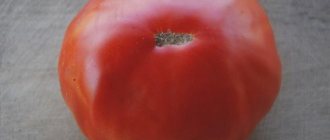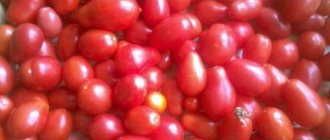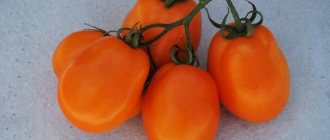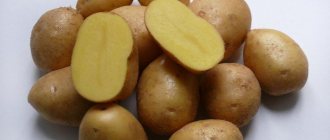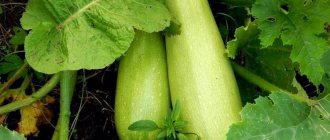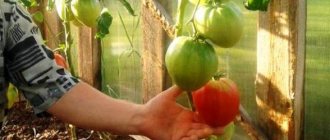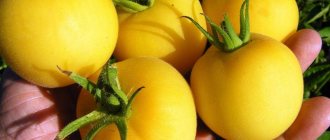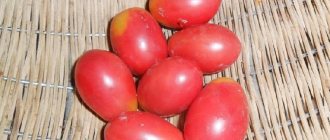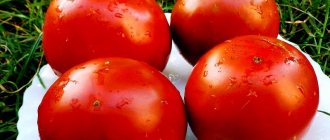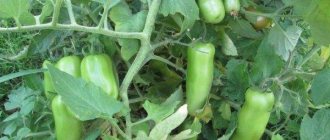| Ripening period: | average |
| Shape, weight of fruits: | truncated heart-shaped, 200-400 g, maximum – 1.5 kg |
| Bush type: | determinant |
| Growing regions: | everywhere |
| Productivity: | 6 kg per sq. m |
Lovers of sweet beef will surely love the Pink Honey tomato. It does not become sour even in cool cloudy summers; the photo of the cut fruit shows that there is only meat, almost no liquid and seeds. Productivity is high regardless of the weather, the tomatoes are very large without rationing - a real advantage. It is not surprising that the cultivar of Siberian selection quickly fell in love with Russian gardeners.
Description and characteristics of the variety
The tomato variety Pink Honey has been in the State Register since 2006. Its appearance is due to agro, the originator is O. V. Postnikova. It is recommended for cultivation in open ground and film greenhouses in all regions.
Have you already planted a Pink Honey tomato?
Yes
50%
No
50%
Description of the bush
The height of the Pink Honey tomato was declared by the breeder as 60-70 cm. But those who planted the variety claim that it tends to stretch. In the garden, under favorable conditions, it can reach 80-100 cm, and in permanent greenhouses - 1.5 m. It is possible that the owners themselves make mistakes, for example, they are zealous with nitrogen, but there are many such reviews.
Rose Honey does not have a very powerful bush. The stems cannot be called frail, but they cannot withstand the weight of the fruit. The leaves are thin, sparse, green, of medium size. In hot weather or when there is a lack of moisture, they are folded into a boat.
Fruit characteristics
According to the description of the State Register, Pink Honey tomatoes are round and ribbed; Siberian Garden calls them truncated heart-shaped. Gardeners who grow tomatoes every year note that even on the same bush, the fruits can sometimes differ, and to the described forms a heart-shaped one with a noticeably elongated lower part is added.
There is no need to say that the cultivar has not established itself - it is more than 15 years old. Re-grading is excluded by the presence of distinctive features of Rose honey:
- multi-chamber;
- Inside there is solid meat, almost no seeds;
- the taste is without sourness, even in a cool rainy summer it is bland-sweet, but when sunny it becomes honey-like;
- very thin skin;
- varietal characteristic - pink color with a moiré tint; if you look closely, the surface is covered with small matte whitish dots, giving an interesting effect;
- at the technical stage, the tomatoes are light green, with a dark spot at the tail - this is the last to be colored when ripe.
The fruits are collected in clusters of 3-6 pieces. This is a typical beef, without rationing, the lower tomatoes can reach 400 g, individual tomatoes when grown in 1 trunk - 700 g. The upper tomatoes are smaller, but also of a decent size - about 160-200 g.
If you set a goal and leave a few ovaries on the bush, Pink Honey tomatoes can be grown gigantic - 1-1.5 kg each.
Fruiting and productivity
The variety produces a harvest in medium terms. From full germination to the first colored tomatoes – 110-120 days. Brushes are tied starting from 6-7 leaves. If topping is not done in time, they will appear before frost.
To ensure that the lower tomatoes reach 700 g, and the upper ones are not smaller than 200 g, it is recommended to leave 4-5 brushes on the bush and pinch the ends.
In open ground, with good care of tomatoes from 1 sq. m harvest about 6 kg. In greenhouses - more, especially if they plant compactly and plant in 1 stem.
Diseases and pests of the variety
Despite its strong immunity, the Rose Honey tomato can get sick and suffer from pest attacks. But if preventive spraying and treatment are carried out in time, the plants will be able to develop normally and produce a full harvest.
To prevent diseases, treatments with Bordeaux mixture are required. For 10 liters of water take 75 g of lime and 100 g of copper sulfate. After thorough mixing, the bushes are sprayed over the leaves. It is advisable to do this in the spring, when the tomatoes are not yet blooming. 2-3 such treatments are needed per year. About 200 ml of product is consumed per square of plantings.
Wood ash is a universal remedy that can prevent fungal diseases and drive pests away from tomatoes.
An infusion of garlic (10 liters of water, 1.5 cups of chopped garlic and 2 g of potassium permanganate) saves plantings from slugs, aphids, and the Colorado potato beetle. 500 ml of product is used per bush. Treatments are done every 2 weeks.
Important!
Most often, tomato bushes get sick and are attacked by pests during periods of high humidity and high temperatures - at the height of summer. It is at this time that you need to pay special attention to the bushes, carry out preventive treatments and remove all weeds that grow on the site.
Wood ash is a universal remedy that can prevent fungal diseases and drive pests away from plantings. It is scattered around the bushes and on the leaves in dry form or a solution is made. For 10 liters of water, take 100 g of wood ash. After 3 hours, when the product has infused, you can spray the tomatoes with it. And so that the solution lingers on the leaves, you can add 50 g of crushed laundry soap to it.
Features of cultivation and care
Rose honey seeds are planted 50-60 days before moving into the ground. Exact times vary depending on region and weather forecast. By the time of planting, the threat of return frosts should have passed, the ground should warm up to 15° C. In the northern regions, it is recommended to keep film or non-woven material on hand for the first time to protect the bushes in case of cold weather.
Seed preparation
The seed manufacturer recommends using stimulants, although gardeners do not complain about poor germination. Mandatory procedures before sowing:
- warming up for 20 minutes at a temperature close to 53° C;
- pickling;
- embryo stimulation;
- soaking until swelling.
Sparging, germination, hardening of tomato seeds and other additional operations - at the request of gardeners. There is no special need for them for high-quality planting material. Seeds treated by the manufacturer (coated, encrusted) are planted dry.
Growing seedlings
Tomato seeds are sown at 1-1.5 cm, laid out every 1-2 cm. The interval between rows is 4 cm. The substrate is moistened with a spray bottle and covered with film or glass. Germinate at 23-25° C.
When seedlings emerge, they are taken to a cool place. They are illuminated around the clock to avoid stretching of the subcotyledon - Rose Honey seedlings especially often suffer from this deficiency.
After a week, the tomatoes are returned to a warm (20-22° C) room. Additional lighting is reduced to 12-14 hours.
They dive in the phase of 2-3 true leaves. It is recommended to immediately bury the seedlings along the cotyledons.
After 10-14 days they begin to feed. There should be enough nitrogen in fertilizers to ensure the growth of green mass, despite the tendency to stretch. Growth is regulated:
- phosphorus and potassium fertilizers;
- a decrease in temperature to 18-20° C during the day, at night – 10-12° C;
- increasing lighting intensity.
Some gardeners leave stretching seedlings under lamps around the clock. This is absolutely impossible to do - the tomatoes will be weak, at night they not only rest, but also absorb the substances accumulated during the day, the products of photosynthesis.
2 weeks before planting, the seedlings are hardened off. First, keep in the fresh air for 20 minutes, then the time is gradually increased. The last nights, tomatoes should spend the night on the street or on an open balcony.
Transplantation and further care
Recommended density – 3 plants per 1 sq. m. They carry pink honey into 2-3 trunks. In a greenhouse, compact planting and formation into 1 stem are possible.
Standard care:
- moderate regular watering;
- after extending the second brush, calcium, phosphorus and potassium should predominate in the fertilizing;
- bush garter;
- loosening or mulching beds;
- removing excess shoots and leaves under the bunch that has begun to fill.
Particular attention should be paid to attaching fruit clusters. They are too heavy for a weak bush and break off easily. The bunches need to be tied to a support. It is convenient to do this on a trellis; a horizontal crossbar should be attached to the vertical pole.
Growing tomatoes
The “Pink Honey” variety is grown exclusively by seedlings.
How to prepare seeds:
- Pre-sowing treatment of seed material is carried out for 20 minutes in a weak manganese solution. Then rinse thoroughly in clean water;
- Then they are treated in a growth stimulator, soaking the seeds for 10-12 hours;
- To increase the resistance of plants to low temperature conditions, planting material is placed in the refrigerator on the bottom shelf for 24 hours.
Sowing seed material:
- Sowing begins in early March;
- Sow the seeds in nutritious soil, which is pre-calcined in the oven;
- Containers for seedlings are also disinfected;
- Seeds are buried in the grooves made at intervals of 2 cm;
- Sprinkle a layer of soil on top and pour water from a spray bottle;
- The containers are covered with film and placed on the windowsill;
- After 10-12 days, the first shoots will appear. The film cover is removed;
- After 2 true leaves have formed, the seedlings are planted in separate pots.
Rules for planting seedlings:
- Planted in a permanent place after stable warm weather has established;
- The site is chosen to be sunny, but without the presence of direct sunlight. It is better to grow in beds after radishes, cabbage, carrots, legumes or garlic. It is not recommended to grow in areas where nightshades, eggplants, zucchini, and cucumbers previously grew. Prepare the bed in the fall. The soil is carefully dug up and fertilizers are added: compost, humus, ash, superphosphate, potassium sulfate;
- Planting holes are placed at intervals of 30-35 cm and filled with wood ash;
- The recommended planting scheme is no more than three seedlings per 1 m2;
- After planting, the bushes are sprinkled with soil and compacted;
- The planted seedlings are watered, and a layer of mulch (peat or dry leaves) is placed next to the ground.
Similar varieties
According to the characteristics and description of the Pink Honey variety, it is similar to beef tomatoes:
- Favorite holiday. Mid-season, determinant, selection - agro, in the State Register since 2008. Bush about 80 cm high, for open ground. The fruits are multi-chambered, fleshy, sweet, with an average weight of 350 g, with normalized ovaries - up to 1.3 kg. The shape is heart-shaped, the color is deep pink. Commercial tomatoes per sq. m gives 7.5 kg.
- Pudovik has been in the State Register since 2007, presented as indeterminate. The breeder claims that the variety is determinate, 1-1.5 m high, depending on the place of cultivation. Tomatoes are ribbed, heart-shaped, multi-chambered, raspberry-colored, sweet, fleshy. Average weight - 300 g, with normalization of ovaries - up to 1.5 kg. Productivity per bush – 5 kg, sq. m gives 15.5 kg.
- Eagle heart. Adopted by the State Register in 2005, the originator is the director V. N. Dederko. On the company’s website it is listed as an amateur variety. Mid-season, determinate, intended for private gardens and small farmers. Tomatoes are heart-shaped, pink-raspberry, weighing up to 400 g. Productivity per square meter. m – 9-14 kg. High resistance to cracking and adverse factors was noted.
- Tomato Pink elephant. A mid-early cultivar with raspberry fruits weighing up to 400 g and a yield of up to 3 kg per bush. The plant is semi-determinate, suitable for growing in open and protected ground.
Tomato variety Pink Honey is a classic beef. Inside it has solid sweet pulp, the skin is so thin that it can be easily removed when fully ripe. It does not require special care, but does need gartering of fruit clusters.
Description of the variety
Fruit:
- Heart-shaped, slightly ribbed;
- With thin pink skin;
- With fleshy, sweet, sugary pulp, without sourness;
- The number of seed chambers is from 4 to 6;
- High solids content;
- Large sizes. Average weight from 300 to 600 grams. The fruits of the first harvest reach from 800 grams to a kilogram.
Bushes:
- Determinate and semi-determinate plant, weakly leafy;
- Height varies from 60 to 140 cm;
- The leaves are medium sized, dark green in color;
- The inflorescence is simple.
Self-collection of seeds
The Pink Honey tomato is a variety, so you can collect the seeds from it yourself. For this purpose, the largest of the first fruits are selected. They are left in a warm place until fully ripened. After their pulp becomes soft, begin to separate the seeds. To do this, cut the tomato into 4-6 parts. Using a knife, the seeds are scraped out of the seed chambers onto a saucer or into any other suitable container.
To completely separate the pulp, they are left in a warm place for 2-3 days. After this, the seed material is poured onto a sieve and washed well in plenty of running water. The peeled seeds are laid out in a thin layer on paper. After complete drying, they are transferred to paper bags or fabric bags.
Photo of the seed collection process.
Features of caring for tomatoes Pink honey
Each tomato variety has its own care characteristics. Rose honey is endowed with large fruits, which encourages gardeners to carry out a special care program for it.
See also Description, characteristics and cultivation of tomato varieties Snegir
Watering mode
When the seedlings move to a new location, the bushes are watered at the rate of 4 liters per plant. Further watering is carried out after 10 days. Before flowering, provide the bushes with moisture 2 times a week at the rate of 2 liters of water per bush.
Important: overwatering makes rose honey susceptible to fungal diseases and the tomato skin cracks.
When flowering begins, the variety is watered weekly. When the fruits are full, watering is carried out 2 times every 7 days. When the fruit turns red, switch back to watering once a week.
What and when to feed plants?
The first feeding of seedlings is done two weeks later in a new place. Then phosphorus, potassium or compost are added before flowering, then before the formation of ovaries. The last feeding occurs during the fruiting period.
Bush formation
Pink tomatoes form 1-2 stems. Side shoots are removed completely or partially. The variety requires support when growing. Tomatoes should be planted in a timely manner, otherwise the yield will decrease.
Pinching and tying
In greenhouses, the Rose Honey tomato grows faster. It can be provided with single supports in the form of ropes or steel rods. In open ground, tomatoes are tied to arched structures. Stepchildren are planted when a sufficient number of leaves appear. Leave 1 stepson under the first brush.
Protection from diseases and pests
Prevention of diseases of these tomatoes is competent care. If a fungus appears, Ridomil or similar products will help. Appropriate insecticides are used for pests.
Advantages and disadvantages of the variety
pros
- fruits of high taste and vitamin value;
- unpretentious and hardy plant;
- long fruiting period;
- sparsely leafed bush;
- Suitable for different regions and growing areas;
- resistant to major diseases;
- Suitable for reproduction by collected seeds.
Minuses
- fruits must be eaten immediately after picking due to their low shelf life;
- wide cracks may form on the largest tomatoes;
- To obtain a pleasant and sugary taste of fruits, plants need regular fertilizing.
A special feature of the variety is uneven ripening, so fresh tomatoes can be consumed for a long period
Bushes heavily loaded with heavy tomatoes need staking.
Disease prevention and protection against pests of tomatoes Pink honey
In addition to the above measures, tomatoes require special treatment for the prevention and treatment of diseases and harmful insects or bacteria.
The drug Ridomil is excellent for this, as it helps prevent the development of fungus and includes active substances - fungicides. Insecticides will help get rid of annoying insects.
Experts advise observing the conditions and requirements regarding care and planting in order to avoid the occurrence of late blight, gray rot and other diseases.
Latest articles for gardeners, gardeners and flower growers
The most productive potato variety for the Middle Zone
How to plant a rose using cuttings from a bouquet
Sowing eustoma seedlings in peat tablets
When can you sow tomatoes for seedlings in 2021 according to the lunar calendar?
Reviews from gardeners about the variety
Anyone who has planted Pink Honey at least once always returns to these tomatoes in the future. You can find many positive reviews about this variety. Gardeners report that such tomato bushes are able to survive after the site is flooded, produce stable yields, and rarely get sick. Pink honey is a valuable type of tomato.
Previous
TomatoesDescription, characteristics and cultivation of tomato Batyanya
Next
TomatoesPlanting tomatoes using the Chinese method: advantages and growing technology
Growing tomatoes without seedlings
Using the seedless method, rose honey can be grown without any hassle. This method has been familiar to experienced gardeners since ancient times, when it was not yet customary to grow seedlings.
In the open ground
The essence of the method is to properly prepare the beds. In mid-April, a plot of land is dug up for tomatoes. Humus and ash are added there. To plant seeds, trenches are dug in advance. They are watered with a weak solution of potassium permanganate. The bottom of each trench is compacted. Then the bed is hidden under film for a week to warm up.
A week later, two tomato seeds are sown at a depth of 1 cm. The distance between the bushes is 40 cm for Rose honey. The seeds are covered with peat or sand. Each seed must be activated and dried, as stated in the article above.
Expert opinion
Stanislav Pavlovich
Gardener with 17 years of experience and our expert
Ask a Question
A week usually passes before the first shoots, then the film can be removed. At first, the plantings are not watered at all. Afterwards care is carried out in the usual way. To strengthen the roots of tomatoes using the seedless method, they are sprinkled with damp soil, and bottles of warm water are placed under the film overnight.
In the greenhouse
In polycarbonate greenhouses, growing tomato bushes using the seedless method is also easy. There is no need to cover the beds with film, and you can start work a week earlier than in open ground. The properties of polycarbonate for tomatoes are such that they create an ideal environment for early growing. We sow pink honey in greenhouses in early April using the technology described above.

